Essay on Modern Machinery Guarding: Presence Sensing Safety Devices
VerifiedAdded on 2023/06/10
|11
|3140
|191
Essay
AI Summary
This essay provides an overview of modern machinery guarding and presence-sensing safety devices, emphasizing their importance in workplace safety. It references the WSH Act in Singapore and discusses various types of machine guards, including fixed, adjustable, and interlocking guards, as well as point guarding and barrier guarding. The essay also details presence-sensing safety devices (PSDs) like light curtains, laser scanners, cameras, and safety mats, highlighting their function in detecting intrusions and halting machine operation to prevent injuries. It stresses the need for additional safeguards and careful positioning of PSDs to avoid false security and ensure effective worker protection.

Running head: ESSAY
Modern design of machinery guarding presence sensing safety devices
Name of the Student
Name of the University
Author Note
Modern design of machinery guarding presence sensing safety devices
Name of the Student
Name of the University
Author Note
Paraphrase This Document
Need a fresh take? Get an instant paraphrase of this document with our AI Paraphraser
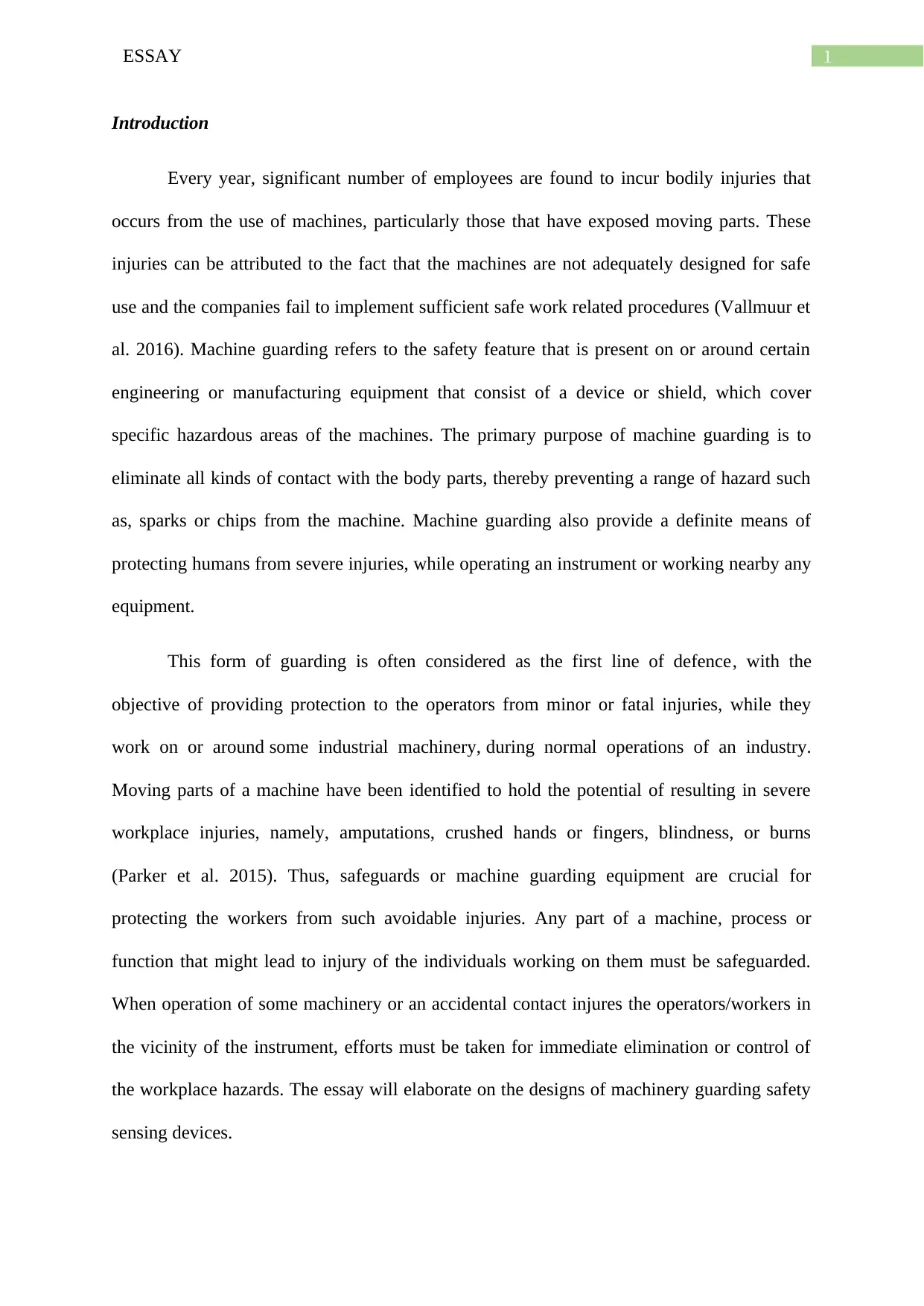
1ESSAY
Introduction
Every year, significant number of employees are found to incur bodily injuries that
occurs from the use of machines, particularly those that have exposed moving parts. These
injuries can be attributed to the fact that the machines are not adequately designed for safe
use and the companies fail to implement sufficient safe work related procedures (Vallmuur et
al. 2016). Machine guarding refers to the safety feature that is present on or around certain
engineering or manufacturing equipment that consist of a device or shield, which cover
specific hazardous areas of the machines. The primary purpose of machine guarding is to
eliminate all kinds of contact with the body parts, thereby preventing a range of hazard such
as, sparks or chips from the machine. Machine guarding also provide a definite means of
protecting humans from severe injuries, while operating an instrument or working nearby any
equipment.
This form of guarding is often considered as the first line of defence, with the
objective of providing protection to the operators from minor or fatal injuries, while they
work on or around some industrial machinery, during normal operations of an industry.
Moving parts of a machine have been identified to hold the potential of resulting in severe
workplace injuries, namely, amputations, crushed hands or fingers, blindness, or burns
(Parker et al. 2015). Thus, safeguards or machine guarding equipment are crucial for
protecting the workers from such avoidable injuries. Any part of a machine, process or
function that might lead to injury of the individuals working on them must be safeguarded.
When operation of some machinery or an accidental contact injures the operators/workers in
the vicinity of the instrument, efforts must be taken for immediate elimination or control of
the workplace hazards. The essay will elaborate on the designs of machinery guarding safety
sensing devices.
Introduction
Every year, significant number of employees are found to incur bodily injuries that
occurs from the use of machines, particularly those that have exposed moving parts. These
injuries can be attributed to the fact that the machines are not adequately designed for safe
use and the companies fail to implement sufficient safe work related procedures (Vallmuur et
al. 2016). Machine guarding refers to the safety feature that is present on or around certain
engineering or manufacturing equipment that consist of a device or shield, which cover
specific hazardous areas of the machines. The primary purpose of machine guarding is to
eliminate all kinds of contact with the body parts, thereby preventing a range of hazard such
as, sparks or chips from the machine. Machine guarding also provide a definite means of
protecting humans from severe injuries, while operating an instrument or working nearby any
equipment.
This form of guarding is often considered as the first line of defence, with the
objective of providing protection to the operators from minor or fatal injuries, while they
work on or around some industrial machinery, during normal operations of an industry.
Moving parts of a machine have been identified to hold the potential of resulting in severe
workplace injuries, namely, amputations, crushed hands or fingers, blindness, or burns
(Parker et al. 2015). Thus, safeguards or machine guarding equipment are crucial for
protecting the workers from such avoidable injuries. Any part of a machine, process or
function that might lead to injury of the individuals working on them must be safeguarded.
When operation of some machinery or an accidental contact injures the operators/workers in
the vicinity of the instrument, efforts must be taken for immediate elimination or control of
the workplace hazards. The essay will elaborate on the designs of machinery guarding safety
sensing devices.
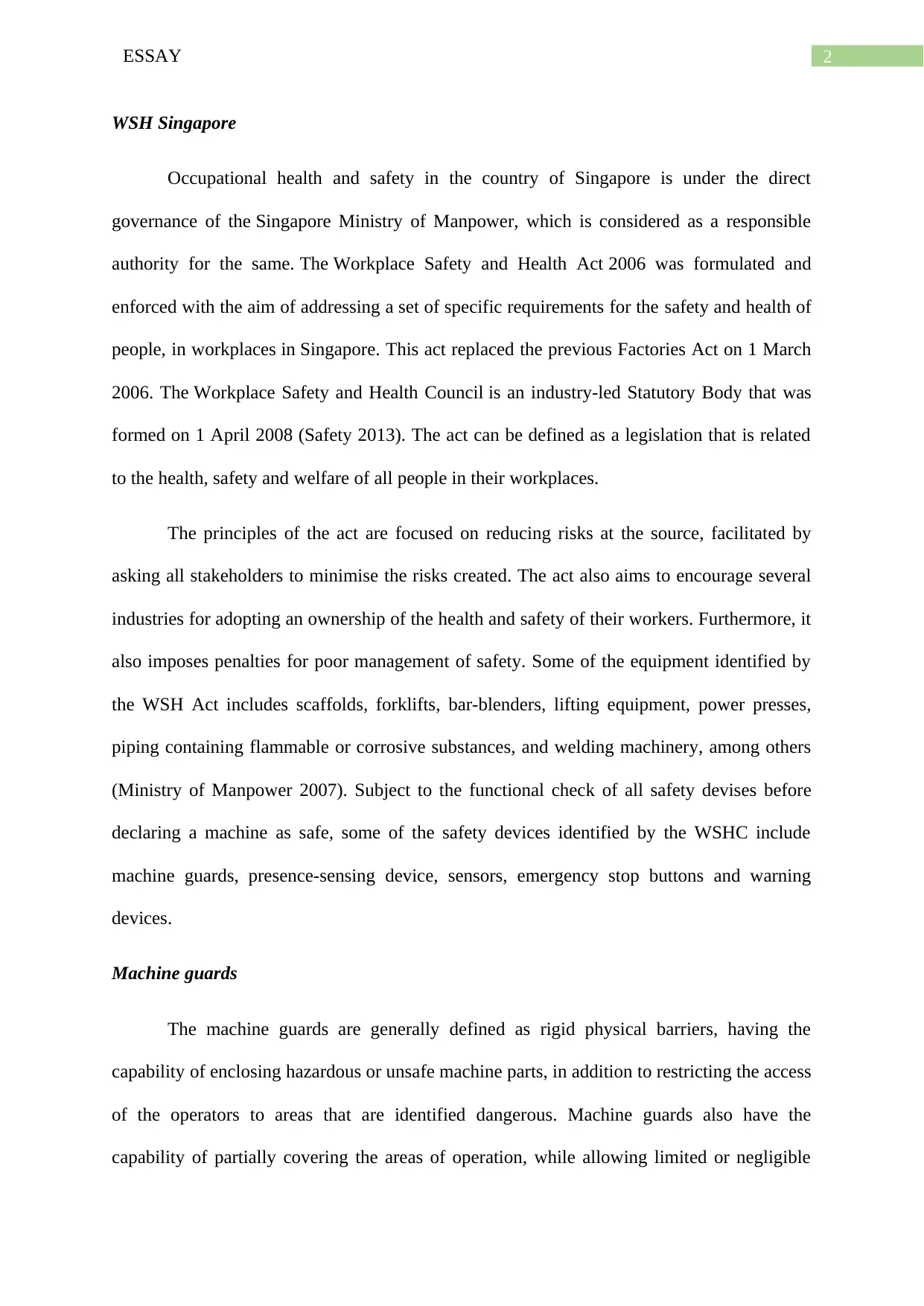
2ESSAY
WSH Singapore
Occupational health and safety in the country of Singapore is under the direct
governance of the Singapore Ministry of Manpower, which is considered as a responsible
authority for the same. The Workplace Safety and Health Act 2006 was formulated and
enforced with the aim of addressing a set of specific requirements for the safety and health of
people, in workplaces in Singapore. This act replaced the previous Factories Act on 1 March
2006. The Workplace Safety and Health Council is an industry-led Statutory Body that was
formed on 1 April 2008 (Safety 2013). The act can be defined as a legislation that is related
to the health, safety and welfare of all people in their workplaces.
The principles of the act are focused on reducing risks at the source, facilitated by
asking all stakeholders to minimise the risks created. The act also aims to encourage several
industries for adopting an ownership of the health and safety of their workers. Furthermore, it
also imposes penalties for poor management of safety. Some of the equipment identified by
the WSH Act includes scaffolds, forklifts, bar-blenders, lifting equipment, power presses,
piping containing flammable or corrosive substances, and welding machinery, among others
(Ministry of Manpower 2007). Subject to the functional check of all safety devises before
declaring a machine as safe, some of the safety devices identified by the WSHC include
machine guards, presence-sensing device, sensors, emergency stop buttons and warning
devices.
Machine guards
The machine guards are generally defined as rigid physical barriers, having the
capability of enclosing hazardous or unsafe machine parts, in addition to restricting the access
of the operators to areas that are identified dangerous. Machine guards also have the
capability of partially covering the areas of operation, while allowing limited or negligible
WSH Singapore
Occupational health and safety in the country of Singapore is under the direct
governance of the Singapore Ministry of Manpower, which is considered as a responsible
authority for the same. The Workplace Safety and Health Act 2006 was formulated and
enforced with the aim of addressing a set of specific requirements for the safety and health of
people, in workplaces in Singapore. This act replaced the previous Factories Act on 1 March
2006. The Workplace Safety and Health Council is an industry-led Statutory Body that was
formed on 1 April 2008 (Safety 2013). The act can be defined as a legislation that is related
to the health, safety and welfare of all people in their workplaces.
The principles of the act are focused on reducing risks at the source, facilitated by
asking all stakeholders to minimise the risks created. The act also aims to encourage several
industries for adopting an ownership of the health and safety of their workers. Furthermore, it
also imposes penalties for poor management of safety. Some of the equipment identified by
the WSH Act includes scaffolds, forklifts, bar-blenders, lifting equipment, power presses,
piping containing flammable or corrosive substances, and welding machinery, among others
(Ministry of Manpower 2007). Subject to the functional check of all safety devises before
declaring a machine as safe, some of the safety devices identified by the WSHC include
machine guards, presence-sensing device, sensors, emergency stop buttons and warning
devices.
Machine guards
The machine guards are generally defined as rigid physical barriers, having the
capability of enclosing hazardous or unsafe machine parts, in addition to restricting the access
of the operators to areas that are identified dangerous. Machine guards also have the
capability of partially covering the areas of operation, while allowing limited or negligible
⊘ This is a preview!⊘
Do you want full access?
Subscribe today to unlock all pages.

Trusted by 1+ million students worldwide
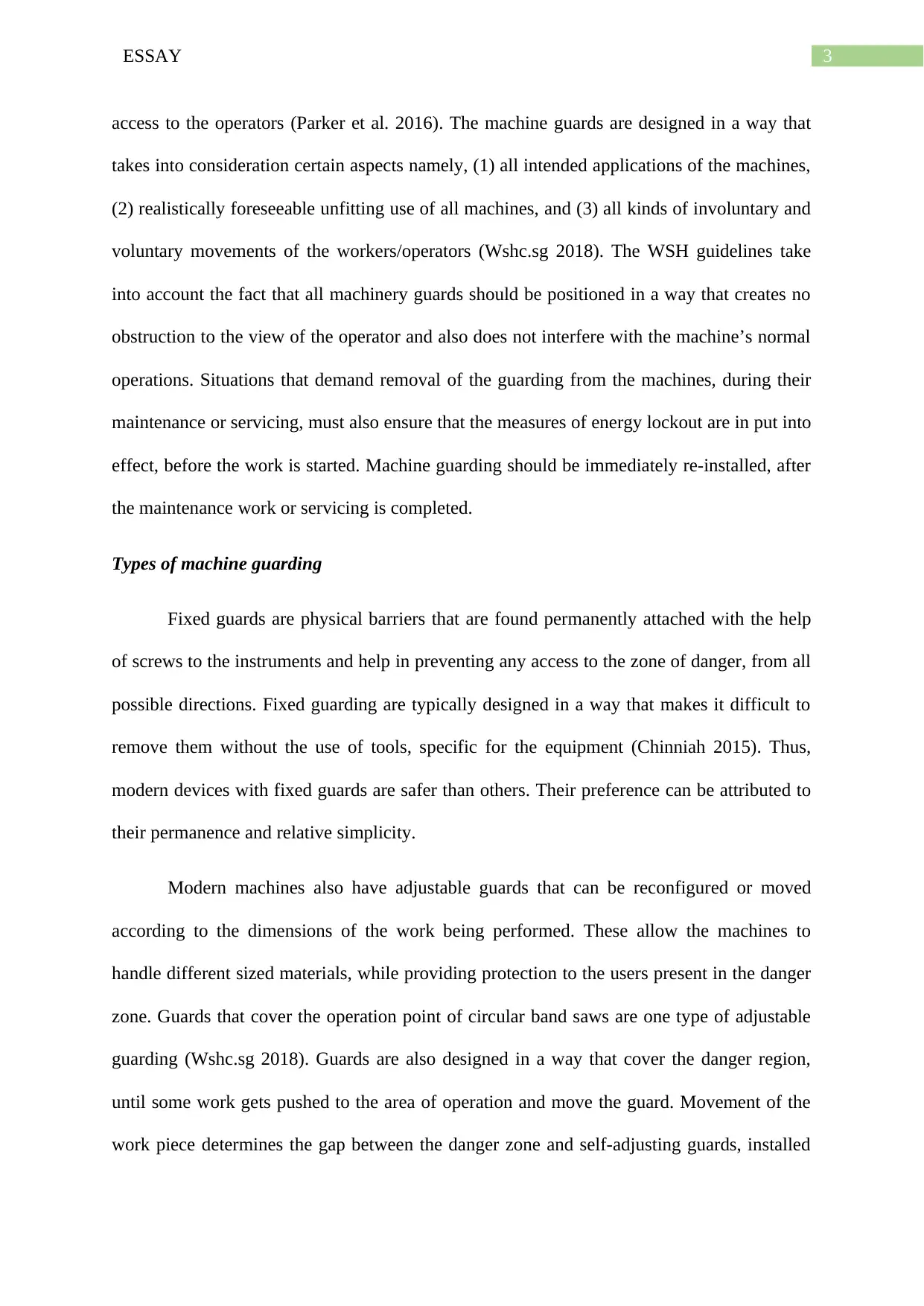
3ESSAY
access to the operators (Parker et al. 2016). The machine guards are designed in a way that
takes into consideration certain aspects namely, (1) all intended applications of the machines,
(2) realistically foreseeable unfitting use of all machines, and (3) all kinds of involuntary and
voluntary movements of the workers/operators (Wshc.sg 2018). The WSH guidelines take
into account the fact that all machinery guards should be positioned in a way that creates no
obstruction to the view of the operator and also does not interfere with the machine’s normal
operations. Situations that demand removal of the guarding from the machines, during their
maintenance or servicing, must also ensure that the measures of energy lockout are in put into
effect, before the work is started. Machine guarding should be immediately re-installed, after
the maintenance work or servicing is completed.
Types of machine guarding
Fixed guards are physical barriers that are found permanently attached with the help
of screws to the instruments and help in preventing any access to the zone of danger, from all
possible directions. Fixed guarding are typically designed in a way that makes it difficult to
remove them without the use of tools, specific for the equipment (Chinniah 2015). Thus,
modern devices with fixed guards are safer than others. Their preference can be attributed to
their permanence and relative simplicity.
Modern machines also have adjustable guards that can be reconfigured or moved
according to the dimensions of the work being performed. These allow the machines to
handle different sized materials, while providing protection to the users present in the danger
zone. Guards that cover the operation point of circular band saws are one type of adjustable
guarding (Wshc.sg 2018). Guards are also designed in a way that cover the danger region,
until some work gets pushed to the area of operation and move the guard. Movement of the
work piece determines the gap between the danger zone and self-adjusting guards, installed
access to the operators (Parker et al. 2016). The machine guards are designed in a way that
takes into consideration certain aspects namely, (1) all intended applications of the machines,
(2) realistically foreseeable unfitting use of all machines, and (3) all kinds of involuntary and
voluntary movements of the workers/operators (Wshc.sg 2018). The WSH guidelines take
into account the fact that all machinery guards should be positioned in a way that creates no
obstruction to the view of the operator and also does not interfere with the machine’s normal
operations. Situations that demand removal of the guarding from the machines, during their
maintenance or servicing, must also ensure that the measures of energy lockout are in put into
effect, before the work is started. Machine guarding should be immediately re-installed, after
the maintenance work or servicing is completed.
Types of machine guarding
Fixed guards are physical barriers that are found permanently attached with the help
of screws to the instruments and help in preventing any access to the zone of danger, from all
possible directions. Fixed guarding are typically designed in a way that makes it difficult to
remove them without the use of tools, specific for the equipment (Chinniah 2015). Thus,
modern devices with fixed guards are safer than others. Their preference can be attributed to
their permanence and relative simplicity.
Modern machines also have adjustable guards that can be reconfigured or moved
according to the dimensions of the work being performed. These allow the machines to
handle different sized materials, while providing protection to the users present in the danger
zone. Guards that cover the operation point of circular band saws are one type of adjustable
guarding (Wshc.sg 2018). Guards are also designed in a way that cover the danger region,
until some work gets pushed to the area of operation and move the guard. Movement of the
work piece determines the gap between the danger zone and self-adjusting guards, installed
Paraphrase This Document
Need a fresh take? Get an instant paraphrase of this document with our AI Paraphraser
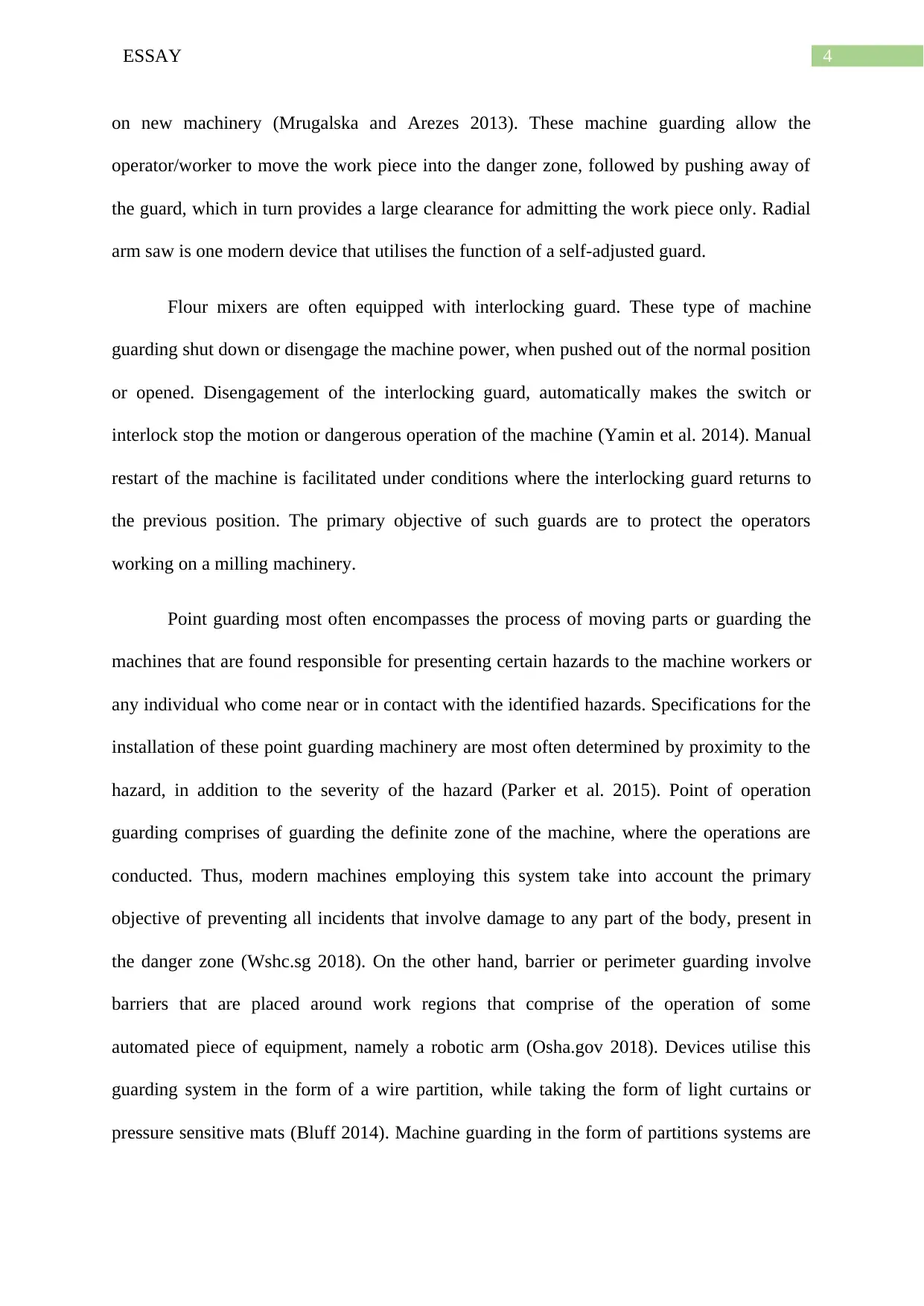
4ESSAY
on new machinery (Mrugalska and Arezes 2013). These machine guarding allow the
operator/worker to move the work piece into the danger zone, followed by pushing away of
the guard, which in turn provides a large clearance for admitting the work piece only. Radial
arm saw is one modern device that utilises the function of a self-adjusted guard.
Flour mixers are often equipped with interlocking guard. These type of machine
guarding shut down or disengage the machine power, when pushed out of the normal position
or opened. Disengagement of the interlocking guard, automatically makes the switch or
interlock stop the motion or dangerous operation of the machine (Yamin et al. 2014). Manual
restart of the machine is facilitated under conditions where the interlocking guard returns to
the previous position. The primary objective of such guards are to protect the operators
working on a milling machinery.
Point guarding most often encompasses the process of moving parts or guarding the
machines that are found responsible for presenting certain hazards to the machine workers or
any individual who come near or in contact with the identified hazards. Specifications for the
installation of these point guarding machinery are most often determined by proximity to the
hazard, in addition to the severity of the hazard (Parker et al. 2015). Point of operation
guarding comprises of guarding the definite zone of the machine, where the operations are
conducted. Thus, modern machines employing this system take into account the primary
objective of preventing all incidents that involve damage to any part of the body, present in
the danger zone (Wshc.sg 2018). On the other hand, barrier or perimeter guarding involve
barriers that are placed around work regions that comprise of the operation of some
automated piece of equipment, namely a robotic arm (Osha.gov 2018). Devices utilise this
guarding system in the form of a wire partition, while taking the form of light curtains or
pressure sensitive mats (Bluff 2014). Machine guarding in the form of partitions systems are
on new machinery (Mrugalska and Arezes 2013). These machine guarding allow the
operator/worker to move the work piece into the danger zone, followed by pushing away of
the guard, which in turn provides a large clearance for admitting the work piece only. Radial
arm saw is one modern device that utilises the function of a self-adjusted guard.
Flour mixers are often equipped with interlocking guard. These type of machine
guarding shut down or disengage the machine power, when pushed out of the normal position
or opened. Disengagement of the interlocking guard, automatically makes the switch or
interlock stop the motion or dangerous operation of the machine (Yamin et al. 2014). Manual
restart of the machine is facilitated under conditions where the interlocking guard returns to
the previous position. The primary objective of such guards are to protect the operators
working on a milling machinery.
Point guarding most often encompasses the process of moving parts or guarding the
machines that are found responsible for presenting certain hazards to the machine workers or
any individual who come near or in contact with the identified hazards. Specifications for the
installation of these point guarding machinery are most often determined by proximity to the
hazard, in addition to the severity of the hazard (Parker et al. 2015). Point of operation
guarding comprises of guarding the definite zone of the machine, where the operations are
conducted. Thus, modern machines employing this system take into account the primary
objective of preventing all incidents that involve damage to any part of the body, present in
the danger zone (Wshc.sg 2018). On the other hand, barrier or perimeter guarding involve
barriers that are placed around work regions that comprise of the operation of some
automated piece of equipment, namely a robotic arm (Osha.gov 2018). Devices utilise this
guarding system in the form of a wire partition, while taking the form of light curtains or
pressure sensitive mats (Bluff 2014). Machine guarding in the form of partitions systems are
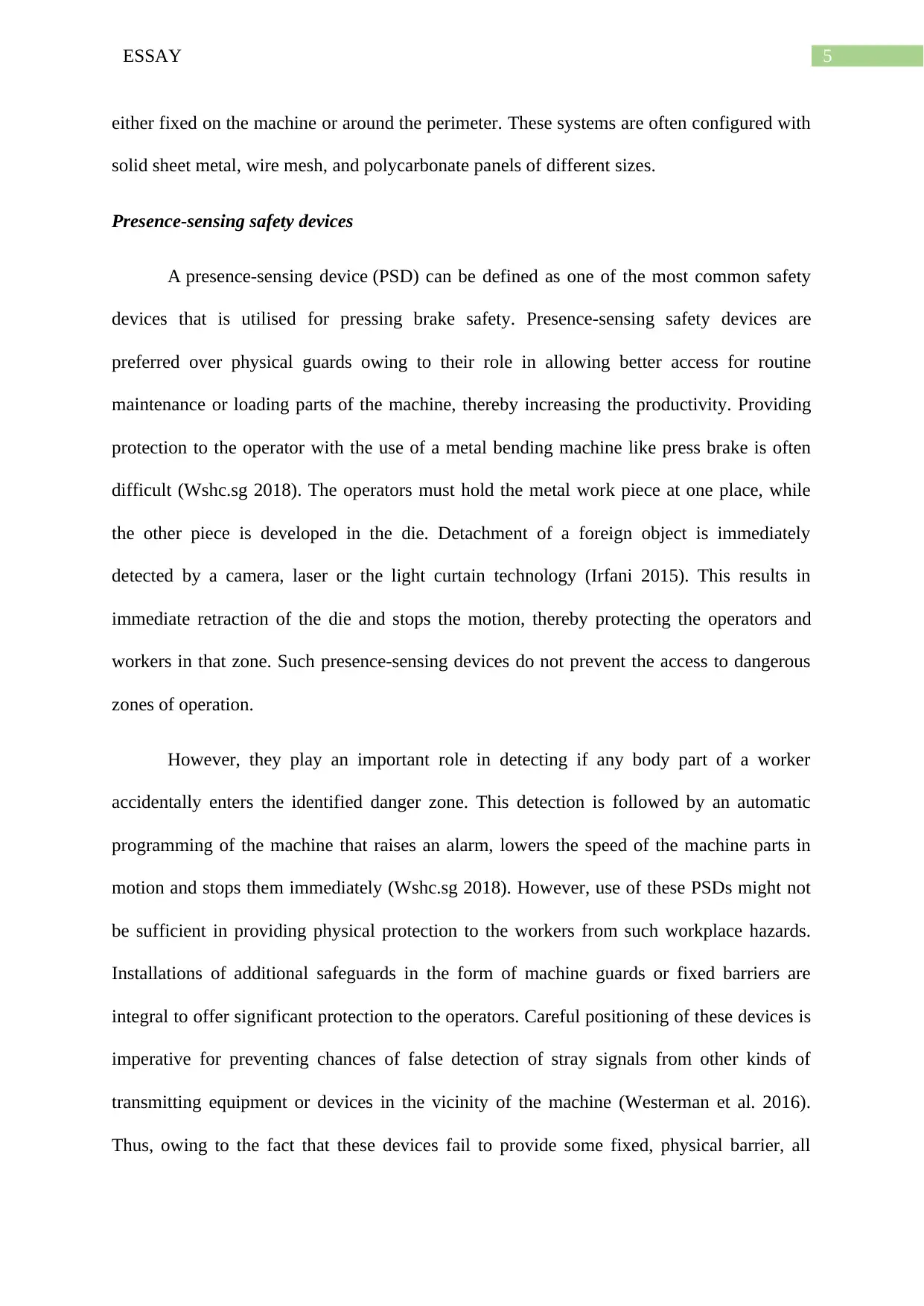
5ESSAY
either fixed on the machine or around the perimeter. These systems are often configured with
solid sheet metal, wire mesh, and polycarbonate panels of different sizes.
Presence-sensing safety devices
A presence-sensing device (PSD) can be defined as one of the most common safety
devices that is utilised for pressing brake safety. Presence-sensing safety devices are
preferred over physical guards owing to their role in allowing better access for routine
maintenance or loading parts of the machine, thereby increasing the productivity. Providing
protection to the operator with the use of a metal bending machine like press brake is often
difficult (Wshc.sg 2018). The operators must hold the metal work piece at one place, while
the other piece is developed in the die. Detachment of a foreign object is immediately
detected by a camera, laser or the light curtain technology (Irfani 2015). This results in
immediate retraction of the die and stops the motion, thereby protecting the operators and
workers in that zone. Such presence-sensing devices do not prevent the access to dangerous
zones of operation.
However, they play an important role in detecting if any body part of a worker
accidentally enters the identified danger zone. This detection is followed by an automatic
programming of the machine that raises an alarm, lowers the speed of the machine parts in
motion and stops them immediately (Wshc.sg 2018). However, use of these PSDs might not
be sufficient in providing physical protection to the workers from such workplace hazards.
Installations of additional safeguards in the form of machine guards or fixed barriers are
integral to offer significant protection to the operators. Careful positioning of these devices is
imperative for preventing chances of false detection of stray signals from other kinds of
transmitting equipment or devices in the vicinity of the machine (Westerman et al. 2016).
Thus, owing to the fact that these devices fail to provide some fixed, physical barrier, all
either fixed on the machine or around the perimeter. These systems are often configured with
solid sheet metal, wire mesh, and polycarbonate panels of different sizes.
Presence-sensing safety devices
A presence-sensing device (PSD) can be defined as one of the most common safety
devices that is utilised for pressing brake safety. Presence-sensing safety devices are
preferred over physical guards owing to their role in allowing better access for routine
maintenance or loading parts of the machine, thereby increasing the productivity. Providing
protection to the operator with the use of a metal bending machine like press brake is often
difficult (Wshc.sg 2018). The operators must hold the metal work piece at one place, while
the other piece is developed in the die. Detachment of a foreign object is immediately
detected by a camera, laser or the light curtain technology (Irfani 2015). This results in
immediate retraction of the die and stops the motion, thereby protecting the operators and
workers in that zone. Such presence-sensing devices do not prevent the access to dangerous
zones of operation.
However, they play an important role in detecting if any body part of a worker
accidentally enters the identified danger zone. This detection is followed by an automatic
programming of the machine that raises an alarm, lowers the speed of the machine parts in
motion and stops them immediately (Wshc.sg 2018). However, use of these PSDs might not
be sufficient in providing physical protection to the workers from such workplace hazards.
Installations of additional safeguards in the form of machine guards or fixed barriers are
integral to offer significant protection to the operators. Careful positioning of these devices is
imperative for preventing chances of false detection of stray signals from other kinds of
transmitting equipment or devices in the vicinity of the machine (Westerman et al. 2016).
Thus, owing to the fact that these devices fail to provide some fixed, physical barrier, all
⊘ This is a preview!⊘
Do you want full access?
Subscribe today to unlock all pages.

Trusted by 1+ million students worldwide
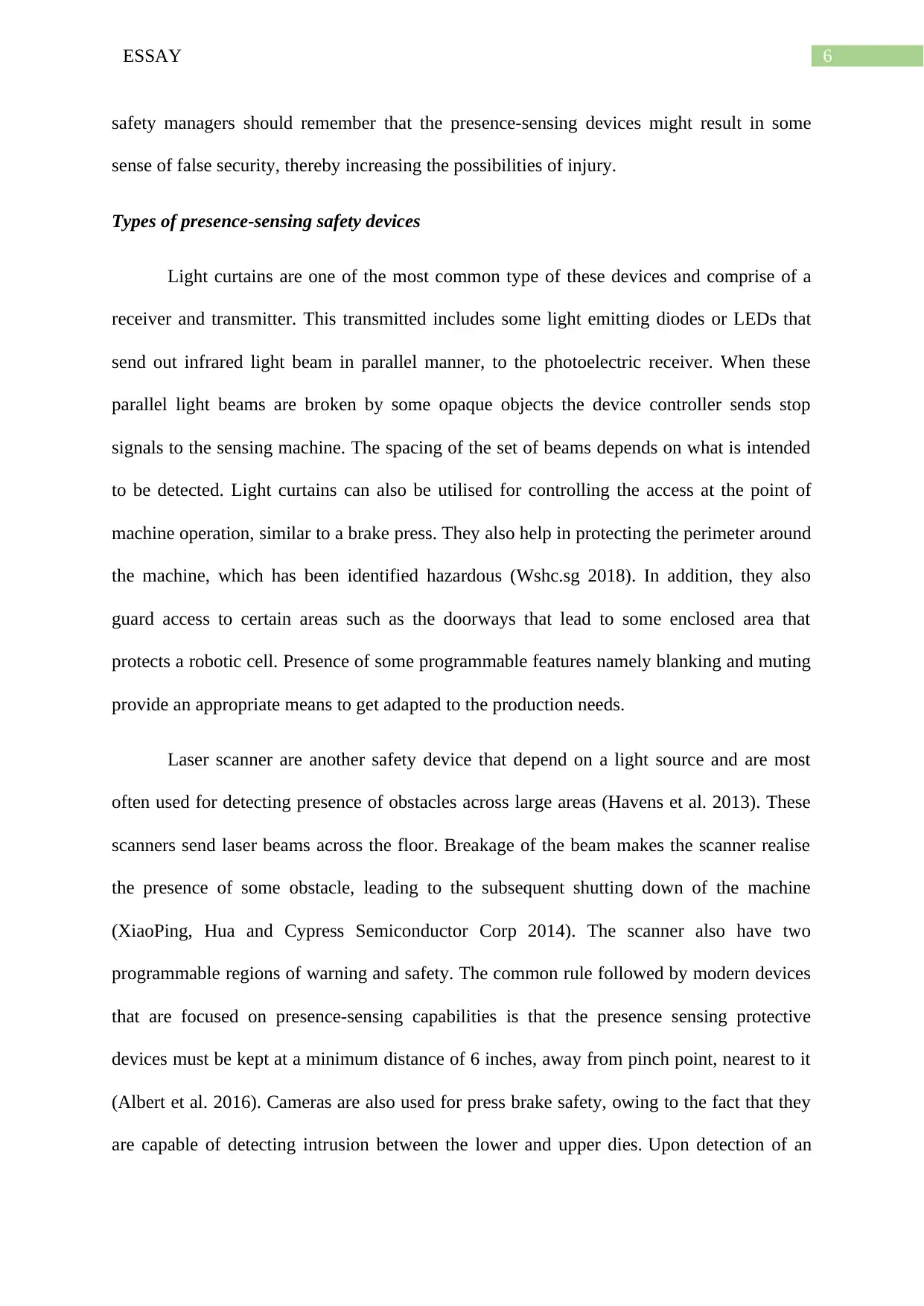
6ESSAY
safety managers should remember that the presence-sensing devices might result in some
sense of false security, thereby increasing the possibilities of injury.
Types of presence-sensing safety devices
Light curtains are one of the most common type of these devices and comprise of a
receiver and transmitter. This transmitted includes some light emitting diodes or LEDs that
send out infrared light beam in parallel manner, to the photoelectric receiver. When these
parallel light beams are broken by some opaque objects the device controller sends stop
signals to the sensing machine. The spacing of the set of beams depends on what is intended
to be detected. Light curtains can also be utilised for controlling the access at the point of
machine operation, similar to a brake press. They also help in protecting the perimeter around
the machine, which has been identified hazardous (Wshc.sg 2018). In addition, they also
guard access to certain areas such as the doorways that lead to some enclosed area that
protects a robotic cell. Presence of some programmable features namely blanking and muting
provide an appropriate means to get adapted to the production needs.
Laser scanner are another safety device that depend on a light source and are most
often used for detecting presence of obstacles across large areas (Havens et al. 2013). These
scanners send laser beams across the floor. Breakage of the beam makes the scanner realise
the presence of some obstacle, leading to the subsequent shutting down of the machine
(XiaoPing, Hua and Cypress Semiconductor Corp 2014). The scanner also have two
programmable regions of warning and safety. The common rule followed by modern devices
that are focused on presence-sensing capabilities is that the presence sensing protective
devices must be kept at a minimum distance of 6 inches, away from pinch point, nearest to it
(Albert et al. 2016). Cameras are also used for press brake safety, owing to the fact that they
are capable of detecting intrusion between the lower and upper dies. Upon detection of an
safety managers should remember that the presence-sensing devices might result in some
sense of false security, thereby increasing the possibilities of injury.
Types of presence-sensing safety devices
Light curtains are one of the most common type of these devices and comprise of a
receiver and transmitter. This transmitted includes some light emitting diodes or LEDs that
send out infrared light beam in parallel manner, to the photoelectric receiver. When these
parallel light beams are broken by some opaque objects the device controller sends stop
signals to the sensing machine. The spacing of the set of beams depends on what is intended
to be detected. Light curtains can also be utilised for controlling the access at the point of
machine operation, similar to a brake press. They also help in protecting the perimeter around
the machine, which has been identified hazardous (Wshc.sg 2018). In addition, they also
guard access to certain areas such as the doorways that lead to some enclosed area that
protects a robotic cell. Presence of some programmable features namely blanking and muting
provide an appropriate means to get adapted to the production needs.
Laser scanner are another safety device that depend on a light source and are most
often used for detecting presence of obstacles across large areas (Havens et al. 2013). These
scanners send laser beams across the floor. Breakage of the beam makes the scanner realise
the presence of some obstacle, leading to the subsequent shutting down of the machine
(XiaoPing, Hua and Cypress Semiconductor Corp 2014). The scanner also have two
programmable regions of warning and safety. The common rule followed by modern devices
that are focused on presence-sensing capabilities is that the presence sensing protective
devices must be kept at a minimum distance of 6 inches, away from pinch point, nearest to it
(Albert et al. 2016). Cameras are also used for press brake safety, owing to the fact that they
are capable of detecting intrusion between the lower and upper dies. Upon detection of an
Paraphrase This Document
Need a fresh take? Get an instant paraphrase of this document with our AI Paraphraser
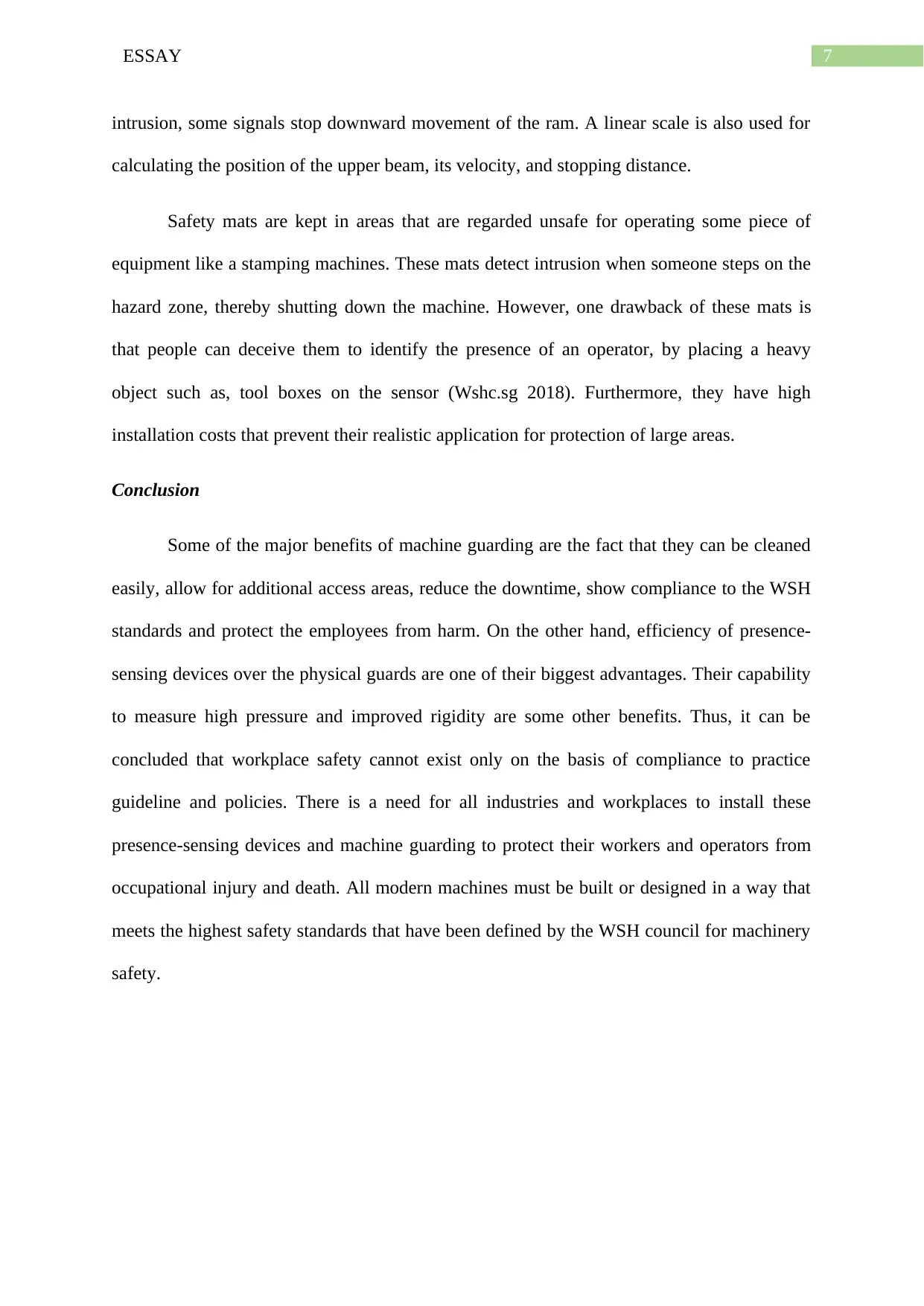
7ESSAY
intrusion, some signals stop downward movement of the ram. A linear scale is also used for
calculating the position of the upper beam, its velocity, and stopping distance.
Safety mats are kept in areas that are regarded unsafe for operating some piece of
equipment like a stamping machines. These mats detect intrusion when someone steps on the
hazard zone, thereby shutting down the machine. However, one drawback of these mats is
that people can deceive them to identify the presence of an operator, by placing a heavy
object such as, tool boxes on the sensor (Wshc.sg 2018). Furthermore, they have high
installation costs that prevent their realistic application for protection of large areas.
Conclusion
Some of the major benefits of machine guarding are the fact that they can be cleaned
easily, allow for additional access areas, reduce the downtime, show compliance to the WSH
standards and protect the employees from harm. On the other hand, efficiency of presence-
sensing devices over the physical guards are one of their biggest advantages. Their capability
to measure high pressure and improved rigidity are some other benefits. Thus, it can be
concluded that workplace safety cannot exist only on the basis of compliance to practice
guideline and policies. There is a need for all industries and workplaces to install these
presence-sensing devices and machine guarding to protect their workers and operators from
occupational injury and death. All modern machines must be built or designed in a way that
meets the highest safety standards that have been defined by the WSH council for machinery
safety.
intrusion, some signals stop downward movement of the ram. A linear scale is also used for
calculating the position of the upper beam, its velocity, and stopping distance.
Safety mats are kept in areas that are regarded unsafe for operating some piece of
equipment like a stamping machines. These mats detect intrusion when someone steps on the
hazard zone, thereby shutting down the machine. However, one drawback of these mats is
that people can deceive them to identify the presence of an operator, by placing a heavy
object such as, tool boxes on the sensor (Wshc.sg 2018). Furthermore, they have high
installation costs that prevent their realistic application for protection of large areas.
Conclusion
Some of the major benefits of machine guarding are the fact that they can be cleaned
easily, allow for additional access areas, reduce the downtime, show compliance to the WSH
standards and protect the employees from harm. On the other hand, efficiency of presence-
sensing devices over the physical guards are one of their biggest advantages. Their capability
to measure high pressure and improved rigidity are some other benefits. Thus, it can be
concluded that workplace safety cannot exist only on the basis of compliance to practice
guideline and policies. There is a need for all industries and workplaces to install these
presence-sensing devices and machine guarding to protect their workers and operators from
occupational injury and death. All modern machines must be built or designed in a way that
meets the highest safety standards that have been defined by the WSH council for machinery
safety.
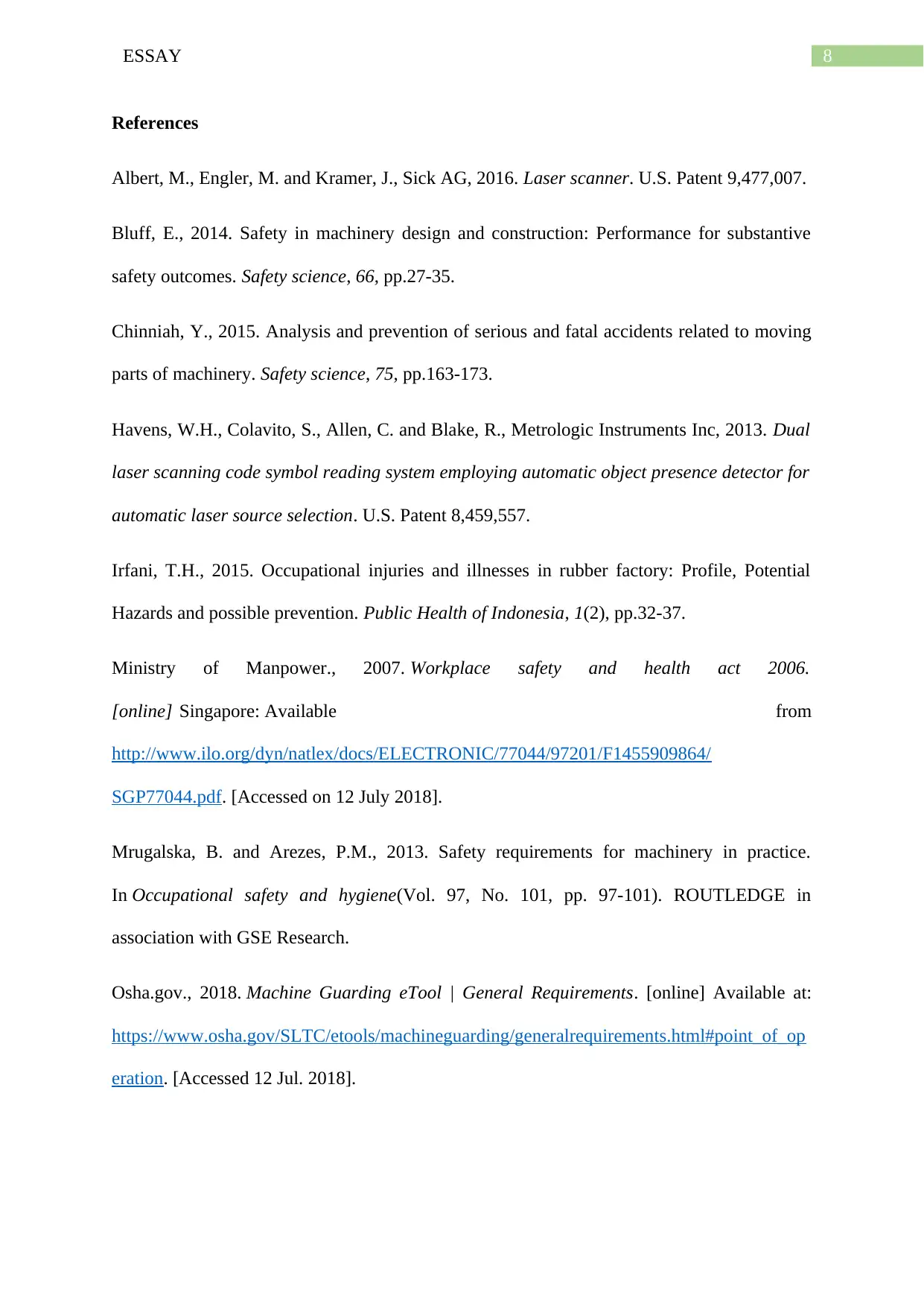
8ESSAY
References
Albert, M., Engler, M. and Kramer, J., Sick AG, 2016. Laser scanner. U.S. Patent 9,477,007.
Bluff, E., 2014. Safety in machinery design and construction: Performance for substantive
safety outcomes. Safety science, 66, pp.27-35.
Chinniah, Y., 2015. Analysis and prevention of serious and fatal accidents related to moving
parts of machinery. Safety science, 75, pp.163-173.
Havens, W.H., Colavito, S., Allen, C. and Blake, R., Metrologic Instruments Inc, 2013. Dual
laser scanning code symbol reading system employing automatic object presence detector for
automatic laser source selection. U.S. Patent 8,459,557.
Irfani, T.H., 2015. Occupational injuries and illnesses in rubber factory: Profile, Potential
Hazards and possible prevention. Public Health of Indonesia, 1(2), pp.32-37.
Ministry of Manpower., 2007. Workplace safety and health act 2006.
[online] Singapore: Available from
http://www.ilo.org/dyn/natlex/docs/ELECTRONIC/77044/97201/F1455909864/
SGP77044.pdf. [Accessed on 12 July 2018].
Mrugalska, B. and Arezes, P.M., 2013. Safety requirements for machinery in practice.
In Occupational safety and hygiene(Vol. 97, No. 101, pp. 97-101). ROUTLEDGE in
association with GSE Research.
Osha.gov., 2018. Machine Guarding eTool | General Requirements. [online] Available at:
https://www.osha.gov/SLTC/etools/machineguarding/generalrequirements.html#point_of_op
eration. [Accessed 12 Jul. 2018].
References
Albert, M., Engler, M. and Kramer, J., Sick AG, 2016. Laser scanner. U.S. Patent 9,477,007.
Bluff, E., 2014. Safety in machinery design and construction: Performance for substantive
safety outcomes. Safety science, 66, pp.27-35.
Chinniah, Y., 2015. Analysis and prevention of serious and fatal accidents related to moving
parts of machinery. Safety science, 75, pp.163-173.
Havens, W.H., Colavito, S., Allen, C. and Blake, R., Metrologic Instruments Inc, 2013. Dual
laser scanning code symbol reading system employing automatic object presence detector for
automatic laser source selection. U.S. Patent 8,459,557.
Irfani, T.H., 2015. Occupational injuries and illnesses in rubber factory: Profile, Potential
Hazards and possible prevention. Public Health of Indonesia, 1(2), pp.32-37.
Ministry of Manpower., 2007. Workplace safety and health act 2006.
[online] Singapore: Available from
http://www.ilo.org/dyn/natlex/docs/ELECTRONIC/77044/97201/F1455909864/
SGP77044.pdf. [Accessed on 12 July 2018].
Mrugalska, B. and Arezes, P.M., 2013. Safety requirements for machinery in practice.
In Occupational safety and hygiene(Vol. 97, No. 101, pp. 97-101). ROUTLEDGE in
association with GSE Research.
Osha.gov., 2018. Machine Guarding eTool | General Requirements. [online] Available at:
https://www.osha.gov/SLTC/etools/machineguarding/generalrequirements.html#point_of_op
eration. [Accessed 12 Jul. 2018].
⊘ This is a preview!⊘
Do you want full access?
Subscribe today to unlock all pages.

Trusted by 1+ million students worldwide
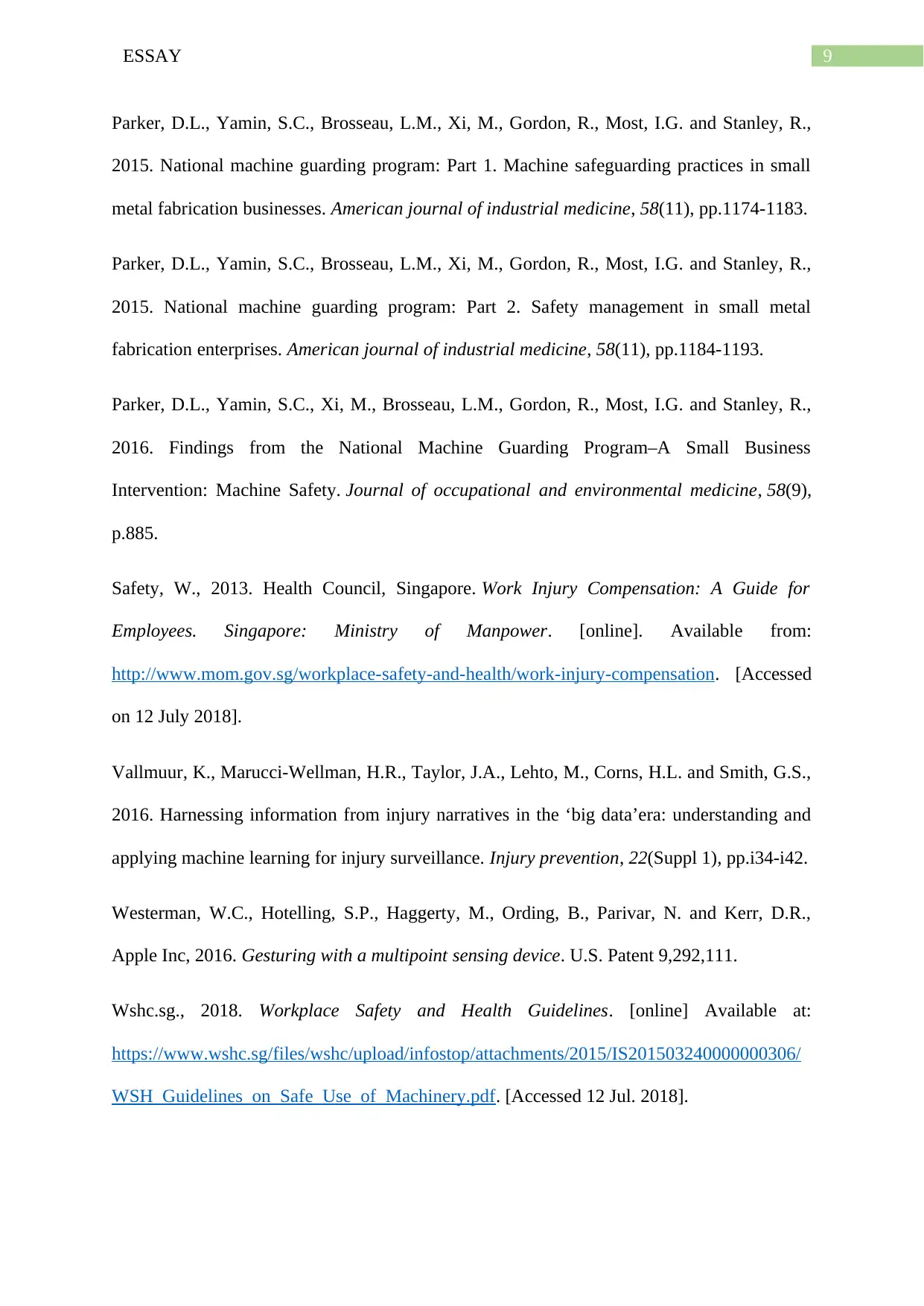
9ESSAY
Parker, D.L., Yamin, S.C., Brosseau, L.M., Xi, M., Gordon, R., Most, I.G. and Stanley, R.,
2015. National machine guarding program: Part 1. Machine safeguarding practices in small
metal fabrication businesses. American journal of industrial medicine, 58(11), pp.1174-1183.
Parker, D.L., Yamin, S.C., Brosseau, L.M., Xi, M., Gordon, R., Most, I.G. and Stanley, R.,
2015. National machine guarding program: Part 2. Safety management in small metal
fabrication enterprises. American journal of industrial medicine, 58(11), pp.1184-1193.
Parker, D.L., Yamin, S.C., Xi, M., Brosseau, L.M., Gordon, R., Most, I.G. and Stanley, R.,
2016. Findings from the National Machine Guarding Program–A Small Business
Intervention: Machine Safety. Journal of occupational and environmental medicine, 58(9),
p.885.
Safety, W., 2013. Health Council, Singapore. Work Injury Compensation: A Guide for
Employees. Singapore: Ministry of Manpower. [online]. Available from:
http://www.mom.gov.sg/workplace-safety-and-health/work-injury-compensation. [Accessed
on 12 July 2018].
Vallmuur, K., Marucci-Wellman, H.R., Taylor, J.A., Lehto, M., Corns, H.L. and Smith, G.S.,
2016. Harnessing information from injury narratives in the ‘big data’era: understanding and
applying machine learning for injury surveillance. Injury prevention, 22(Suppl 1), pp.i34-i42.
Westerman, W.C., Hotelling, S.P., Haggerty, M., Ording, B., Parivar, N. and Kerr, D.R.,
Apple Inc, 2016. Gesturing with a multipoint sensing device. U.S. Patent 9,292,111.
Wshc.sg., 2018. Workplace Safety and Health Guidelines. [online] Available at:
https://www.wshc.sg/files/wshc/upload/infostop/attachments/2015/IS201503240000000306/
WSH_Guidelines_on_Safe_Use_of_Machinery.pdf. [Accessed 12 Jul. 2018].
Parker, D.L., Yamin, S.C., Brosseau, L.M., Xi, M., Gordon, R., Most, I.G. and Stanley, R.,
2015. National machine guarding program: Part 1. Machine safeguarding practices in small
metal fabrication businesses. American journal of industrial medicine, 58(11), pp.1174-1183.
Parker, D.L., Yamin, S.C., Brosseau, L.M., Xi, M., Gordon, R., Most, I.G. and Stanley, R.,
2015. National machine guarding program: Part 2. Safety management in small metal
fabrication enterprises. American journal of industrial medicine, 58(11), pp.1184-1193.
Parker, D.L., Yamin, S.C., Xi, M., Brosseau, L.M., Gordon, R., Most, I.G. and Stanley, R.,
2016. Findings from the National Machine Guarding Program–A Small Business
Intervention: Machine Safety. Journal of occupational and environmental medicine, 58(9),
p.885.
Safety, W., 2013. Health Council, Singapore. Work Injury Compensation: A Guide for
Employees. Singapore: Ministry of Manpower. [online]. Available from:
http://www.mom.gov.sg/workplace-safety-and-health/work-injury-compensation. [Accessed
on 12 July 2018].
Vallmuur, K., Marucci-Wellman, H.R., Taylor, J.A., Lehto, M., Corns, H.L. and Smith, G.S.,
2016. Harnessing information from injury narratives in the ‘big data’era: understanding and
applying machine learning for injury surveillance. Injury prevention, 22(Suppl 1), pp.i34-i42.
Westerman, W.C., Hotelling, S.P., Haggerty, M., Ording, B., Parivar, N. and Kerr, D.R.,
Apple Inc, 2016. Gesturing with a multipoint sensing device. U.S. Patent 9,292,111.
Wshc.sg., 2018. Workplace Safety and Health Guidelines. [online] Available at:
https://www.wshc.sg/files/wshc/upload/infostop/attachments/2015/IS201503240000000306/
WSH_Guidelines_on_Safe_Use_of_Machinery.pdf. [Accessed 12 Jul. 2018].
Paraphrase This Document
Need a fresh take? Get an instant paraphrase of this document with our AI Paraphraser

10ESSAY
XiaoPing, J., Hua, L. and Cypress Semiconductor Corp (US), 2014. Sensing device. U.S.
Patent 8,803,813.
Yamin, S.A.M.U.E.L., Parker, D.A.V.I.D., Brosseau, L.I.S.A., Gordon, B. and Xi, M., 2014.
National Machine Guarding Program: design of a machine safety intervention. Safety Science
Monitor (Sweden), 18(1), pp.1174-1183.
XiaoPing, J., Hua, L. and Cypress Semiconductor Corp (US), 2014. Sensing device. U.S.
Patent 8,803,813.
Yamin, S.A.M.U.E.L., Parker, D.A.V.I.D., Brosseau, L.I.S.A., Gordon, B. and Xi, M., 2014.
National Machine Guarding Program: design of a machine safety intervention. Safety Science
Monitor (Sweden), 18(1), pp.1174-1183.
1 out of 11
Related Documents
Your All-in-One AI-Powered Toolkit for Academic Success.
+13062052269
info@desklib.com
Available 24*7 on WhatsApp / Email
![[object Object]](/_next/static/media/star-bottom.7253800d.svg)
Unlock your academic potential
Copyright © 2020–2025 A2Z Services. All Rights Reserved. Developed and managed by ZUCOL.




